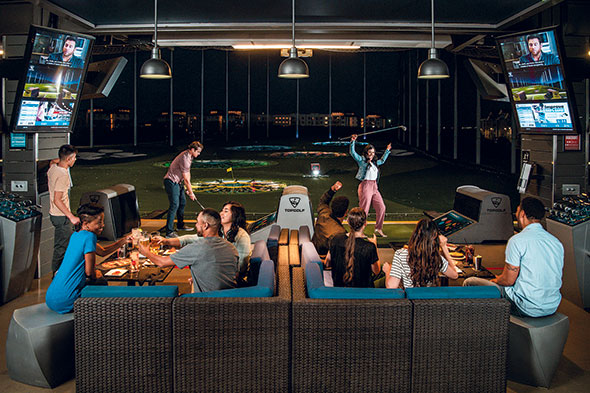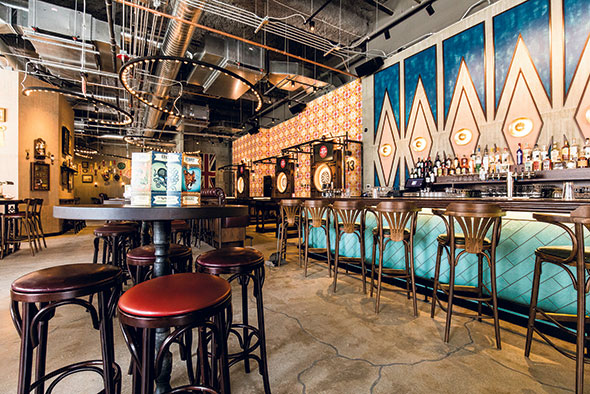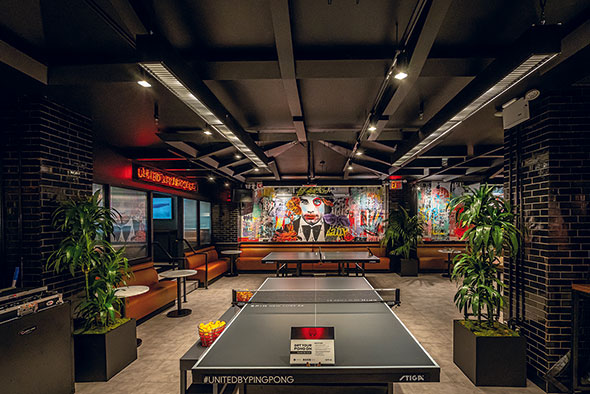How about some ginger pork dumplings or Korean short rib baos with your dart game? Table tennis and grilled chicken thigh kebabs, anyone? Or maybe it’s some wine and pasta while viewing the latest blockbuster — or a local craft beer and smoked brisket sandwich at the ballgame?
 Topgolf patrons dine on flatbreads and other upscale comfort food while taking turns practicing their swing at the driving range.
Topgolf patrons dine on flatbreads and other upscale comfort food while taking turns practicing their swing at the driving range.
Gone are the days when hot dogs, burgers, popcorn and other standard concession fare were good enough at entertainment venues — if guests were offered food at all. Today, these concepts continue to truly up their game when it comes to food and beverage by offering a wider variety of chef-crafted fare and well-thought-out cocktails that staff can execute in a high-volume format. There’s even a new phrase for this growing segment: “eatertainment.”
Eatertainment concepts take shape in different ways. Technically, ballparks and other sporting venues with stepped-up menus and club/suite offerings fit into this category. The term can also apply to live music venues with enhanced food options. The recent onslaught of concepts with arcades, virtual reality, indoor driving ranges and other gaming venues seem to offer something delicious to nosh on. The modern theater looks nothing like it did in the past. In some cases, full-service dining and bar service are available right at guests’ seats.
The growth of these eatertainment concepts shows no signs of slowing down. In a recent report on U.S. restaurants, Los Angeles-based real estate firm CBRE Group predicted that such concepts will continue to open. At the same time, millions of new sporting venues feature preeminent foodservice and bar programs.
“As eatertainment operators downsize to smaller, tech-driven formats, they will infill urban locations and be a catalyst for revitalization of urban main streets in select markets,” the CBRE report states. “Consumer demand is rising for more experience-rich recreation and dining options in retail properties. Its incorporation in malls and non-mall settings has grown by 44.7 percent and 68.5 percent, respectively, since 2010.”
In addition, the report found that 70 percent of consumers prefer to visit these eatertainment venues for group outings instead of casual-dining operations. Research firm Datassential shows similar results in its studies on the subject, reporting that 59 percent of consumers like the idea of eatertainment and would visit such concepts.
Rick Gresh, director of U.S. culinary operations for AceBounce, has seen this firsthand at both the AceBounce Ping-Pong concept in Chicago and the company’s Flight Club concept for dart gaming, also in Chicago. The company plans to open locations in Boston and Las Vegas. “We highlight our food program, but in the past, this wasn’t the case with most entertainment venues,” he says. “You had to either eat before or after the activity. We offer a one-stop shop, and our guests are always pleasantly surprised with the fresh, beautiful food we put out and high-quality cocktails that keep them saying, ‘Hey, let’s not leave — let’s stay longer.’”
 Flight Club in Chicago features high-tech, digitalized dart boards for gaming as well as a full-service bar and restaurant with chef-crafted dishes.
Flight Club in Chicago features high-tech, digitalized dart boards for gaming as well as a full-service bar and restaurant with chef-crafted dishes.
New and revamped sporting venues also see a food and drink renaissance these days as developers and sports teams throughout the U.S. and Canada continue to invest millions of dollars to improve offerings. “Baseball in particular is a marathon when it comes to sports viewing, so good food and drink over the course of several hours is a must,” says Taylor Park, executive chef for Centerplate, the foodservice operator at T-Mobile Park, home to Major League Baseball’s Seattle Mariners.
Even longtime eatertainment concept Dave & Busters, based in Dallas, has stepped up its game. Last year, the chain reconceptualized 75 percent of its menu to feature more premium items. Italian sausage, pepperoni, Manchego and cheddar cheese quesadilla pizza, anyone?
And then there’s longtime entertainment-plus-restaurant concept Chuck E. Cheese, which has made major changes, including dumping its signature animatronic mouse band as well as introducing an updated menu that includes gluten-free cauliflower-crust pizza. This comes on the heels of the chain reporting a whopping $15.3 million net loss for the third quarter of 2019.
As one would expect, this growing segment of eatertainment will continue to have a strong impact on design and equipment selection. Regardless of the format — ballpark or a bowling alley — there are few common themes when it comes to the nature of the design and on the equipment and supplies needed.
 SPIN in New York City offers table games alongside food and drink, making it a popular spot for parties and other social gatherings.
SPIN in New York City offers table games alongside food and drink, making it a popular spot for parties and other social gatherings.
High Volume, High Taste
When Gresh describes his job, it sounds like he’s running the foodservice program at a major college or university. Although he says AceBounce started out as a 100 percent from-scratch, handmade operation, after trying to hand-shape and cook up to 2,000 dumplings and 1,800 chicken skewers a day, he quickly realized he would have to implement other strategies to keep up with the demand while not sacrificing the food’s taste and quality.
That meant investing in specialty dumpling-making equipment as well as an external commissary that could produce skewers of chicken thighs to Gresh’s specs. His team marinates the skewers in large, insulated coolers before searing on grills and finishing them to temperature in combi ovens to maintain proper moisture levels when holding. The same commissary also prepares Flight Club’s peppery meatballs that the restaurant cook staff then simmer in a tomato-based sauce in large hotel pans, which are held in combis and/or hot wells until use in sandwiches or atop pizzas.
Working with the commissary had another benefit: Having the poultry prep work occur off-site in an HACCP-certified facility helps on the food safety front, and it frees up labor at the restaurant level by allowing cooks to focus on other jobs. The combi ovens, holding cabinets and hot wells also help the team keep batch-cooked items fresh, especially since preordering for private parties accounts for 50 percent to 90 percent of food orders at AceBounce and Flight Club, according to Gresh.
Superior Storage
As one would expect, storage and dishwashing represent important pieces of the puzzle at a high-volume entertainment venue like AceBounce and Flight Club.
“We put out way more plates than a traditional restaurant and stagger party platters 20 skewers at a time versus 60 — and then there are all the shared plates,” Gresh says. As such, shelving and risers throughout the kitchen and under counters help store all these supplies. Also, having plenty of surfaces throughout the kitchen where plates can land is a must. Flight Club even has to store extra darts in case someone has a seafood allergy, for example, and cannot use the regular darts due to risk of potential contamination. Darts are sanitized in between parties.
In the dish room, AceBounce has invested in 66-inch, flight-type conveyor dishwashers, and all the bars have their own dishwashers. “We can’t mess around when it comes to getting the dishes done,” Gresh says.
Fun and Functional Equipment
With two busy clubs, an a la carte restaurant and about 95 concession stands, Centerplate’s Chef Park is no stranger to high volume. Still, he prefers to work with well-known Seattle chefs to curate locally inspired menus. Choosing authentic yet still functional equipment is a must for his team.
For example, Park installed two large smokers on the concession level at T-Mobile Park, not only to entice fans with the alluring smell of barbecue but also to cook 2,000 pounds of meat a day, including brisket, short ribs, prime rib, and even smoked potatoes and smoked tenderloins for the club level.
Park’s team will also be piloting the use of a robotic pizza-making platform capable of producing as many as 180 to 300 pizzas per hour. In addition, Park relies on a large, gas-fired, dome-shaped pizza oven to cook pizzas and flatbreads as well as roast vegetables for other dishes. Most of the equipment in both the main kitchen, used for catering and in-seat service, and the concessions kitchens sits on casters so staff can easily move these items as menus change or the team makes new equipment purchases.
Beefed-Up Bar and Beverage
As one would guess, alcohol and beverage sales represent huge revenue streams at eatertainment concepts, so the design and equipment of these spaces must support the volume. Nashville, Tenn., area-based Sean King of Culinary Consulting & Design, who has worked on kitchens at live entertainment venues, says his clients in this space tend to have a 60/40 alcohol to foodservice sales split, so extra room becomes necessary for not only full-service bars but also extensive beer and wine taps, liquor shelving and storage, and more.
“Most of the live music venues I have worked on or visit are set up with fewer seats for foodservice and more room for alcohol and bar service,” says King. He has seen an increased use recently, at least in Nashville, of key fobs or wristlets that can link to credit cards for self-service beer taps. “The venue can set parameters, like cut off the user after 32 ounces, while also assigning staff to monitor the area,” he says.
T-Mobile Park features an extensive draft system, not just for beer but also for wine and batched cocktails. Lines run to the taps at the concession and club levels from dedicated walk-in coolers with the kegs and tanks. Some of the taps even pour cold-brew coffee. And Park says the beer taps, in particular, get switched more frequently to feature a rotating selection of local craft brews.
Tech Toppers
One may argue these eatertainment companies, with their card-scanning arcades, virtual reality and other digitalized gaming, essentially function as mini tech companies. Well, the embrace of technology extends to the front-of-the-house ordering system as well as to the kitchen. Case in point: Topgolf plans to scale down its roughly 55,000-square-foot venues to take the form of a Top Lounge concept hovering around 7,500 square feet. This development will also include a greater investment in technology for both virtual golf gaming and dining services.
In the sports segment, technology is king when it comes to facilitating in-seat dining and on-demand concessions in general. Some designers and operators now incorporate remote ordering via phone apps, with designated pickup at the concession stands, in their plans. Take, for example, BC Place, home to Major League Soccer’s Vancouver Whitecaps FC. This Centerplate-managed foodservice program offers in-seat ordering, not through an app but through a QR code on armrests that fans can scan with their smartphones.
T-Mobile Park is deciding which technology to use for its remote ordering program. One potential option is providing handheld tablets to servers in the clubs for faster order and payment processing, according to Park.
New technologies also have major benefits for the back of the house at eatertainment venues. AceBounce’s kitchens use one technology program that collects and stores recipes, photos, video demonstrations and even expiration labels for printing (no more blue tape and Sharpies), all in the cloud. This allows managers to access the information from wherever they are. Gresh can also make real-time changes to menus and other information in the system. This approach supports the operator’s HACCP program, housing management checklists and pinging managers if food temperatures are not logged according to predetermined schedules. “We’re not using pens and paper, so people can’t fudge the times and temperatures anymore,” he says. “Food safety is huge for us.”
Operators can opt to integrate these systems to mine the data for menu trends, customer information and other nuggets, something Gresh says is an important part of his menu and daily prep planning.
As eatertainment concepts like AceBounce, ballparks and more continue to pop up around the country, the equipment and supplies community will be challenged with designing and equipping these kitchens and bars with the right pieces, technologies and tools to pump out volumes of tasty food and drink fast, freshly and safely. With ample room for growth, now is certainly the time to get into the game.



